
|
Deaths Scenes 1984 |

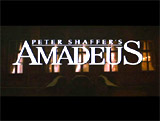
|
Director Milos Forman's Best Picture winning drama was a fictionalized biography of tortured genius and Viennese child prodigy Wolfgang Amadeus Mozart (Tom Hulce). The story was presented through the eyes of fellow jealous composer Antonio Salieri (F. Murray Abraham), who was confined in an asylum, and shared flashbacks with the hospital's cleric, Father Vogler (Richard Frank). Mozart experienced a quiet death in bed in 1791 at the age of 35. He was stricken with liver disease (and probably acute rheumatic fever), while also suffering from exhaustion due to the demands of composing. Salieri had disguised himself as a mysterious benefactor to commission Mozart to write his final piece - Requiem Mass in D Minor - it was an effort that eventually killed him. When Mozart's wife Constanze (Elizabeth Berridge) returned to her home, she found Salieri at Mozart's side. She ordered: "He's not to work on this anymore. It's making him ill," locked up the sheets of unfinished music manuscript in a cabinet, and then insisted for Salieri to leave. But it was already too late. When she came to her husband's bedside, Mozart had already expired. She repeatedly cried out her pet name: "Wolfi" - as Salieri also stood stunned by the thought of a deceased Mozart. A sparse funeral-church service was held on a very rainy day in Vienna. Mozart's corpse - placed into a plain, cheap dark wooden coffin and carried by four pallbearers, was taken by carriage to the outskirts of town. All of the mourners stopped at the outer gate as the cart moved on to the cemetery. There a local priest crossed himself, as three gravediggers carried the coffin unceremoniously over to a communal, mass pauper's grave and tipped it, so that the canvas-wrapped body slid out of one end of the coffin. Mozart's corpse was anonymously dumped into an open dirt pit with other sacks of bodies, and was covered with two shovel-fuls of white lye.
In 1823, the aging royal composer Salieri, the champion and "patron saint" of mediocrities who had gone insane and had been placed in an asylum, looked back at Mozart's premature death. Not humbled in any way by his complicity, Salieri was angry at God, expressing his incensed frustration at the young visibly-emotional priest. He pondered the irony of how a merciful God had spitefully and deliberately destroyed and killed Mozart ("his own beloved"), rather than giving the mediocre-talented Salieri any share of "the smallest part of his glory":
|
 Constanze with Husband Mozart  Antonio Salieri  Mozart's Death  Salieri  Salieri's Jealous Anger about Mozart's Premature Death Told to Priest |
|||||||||

|
Blood Simple (1984) The Coen Brothers' complex neo-noir crime film featured an incredible set of death scenes. Texas bar owner Julian Marty (Dan Hedaya) was buried alive by bartender Ray (John Getz) in a dirt field. Ray had wrongly assumed that his lover Abby (Frances McDormand) had killed her husband Marty. To protectively hide the corpse, he drove Marty's dead body to a remote rural field in the middle of the night, but realized that Marty was still alive, when he was found crawling away from the car! He resisted bashing him over the head with a shovel, but then buried the struggling-to-live Marty in a hole that he dug. He was slowly able to cover him up with dirt before sunrise. In the film's final stand-off between Abby and duplicitous private detective Loren Visser (M. Emmet Walsh) - he was the one who had actually been hired by Marty to kill the cheating couple (and shot Marty in betrayal after being paid $10,000); Abby shot Visser in the abdomen through a bathroom door as he was stalking her. She thought it was her husband Marty: ("I'm not afraid of you, Marty," she said matter-of-factly). As Visser lay dying on the floor in the next room with a gunshot to the abdomen, he burst into guffaws of laughter with the film's final line:
He died with a view of the sink's dripping plumbing above him. |
    Marty Buried Alive by Ray |
|||||||||
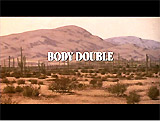
|
Body Double (1984) In this Brian DePalma thriller noted for lurid violence and sex, pretty exhibitionist neighbor Gloria Revelle (Deborah Shelton) suffered a grisly and brutal death. The killer was disguised wearing a mask of some sort, and appeared to be an Indian. The film's tagline gave a huge hint: "You can't believe everything you see." In the scene subsequent to her death, struggling horror film actor Jake Scully (Craig Wasson), who suffered from claustrophobia, had followed Gloria to a beach area as she was being stalked by a mysterious, menacing Indian who had snatched her purse. Upon returning home to his bachelor pad that he was 'house-sitting' for an actor's workshop friend named 'Sam Bouchard' (Gregg Henry), Jake watched in horror (through a high-powered telescope) as he voyeuristically viewed Gloria being assaulted by the Indian in her nearby apartment. Although it appeared to be a simple theft case (the purse-snatching Indian had taken her card key), the nature of the horrendous killing raised some doubts. In the lengthy death scene, the helpless Gloria was first half-strangled with a phone cord, as she was lifted off the floor and held in a death grip. When they both fell backwards onto the bed, the Indian's head struck his power-drill and he was temporarily knocked out.
Then, after he gained consciousness, he stalked and terrorized her with a huge erect, phallic-like power drill the size of a jackhammer. The giant whirring bit of the drill came down between the killer's legs in a symbolic pose. It penetrated through her supine body and into the floor. It emerged from a hole in the ceiling in the room a floor below. Blood tricked down through the opening. Scully arrived too late to save Gloria from being murdered, when he was delayed by an attack from a vicious dog (it was later revealed to be "Sam's" dog) in the apartment below.
|
   Drilled to Death and Penetrating Through the Floor Below |
|||||||||

|
Crimes of Passion (1984) British director Ken Russell's neon-lit, dark, "guilty pleasure" cult tale and controversial erotic thriller was about the lethal relationship between an LA prostitute (living a double life) and a fanatical preacher:
The film's concluding death scene involved an assaultive face-off between the film's two main characters in her apartment. The Reverend carried a razor-tipped chrome-steel vibrating dildo (dubbed his "Superman") - one of his sex toys - in his doctor's bag. Early on, China Blue asked prophetically:
Before his death, he told China Blue about his desire to save her once and for all:
The violent altercation was predicated on the Reverend's desire to save her, as he played demented songs on a piano to her as she was tied down to her drafting table.Although it appeared that China Blue would be the victim, they reversed roles and she approached him with the dildo as he pleaded to be killed:
But then the roles switched again, when he said: "Too late!" The character wearing China Blue's dress was stabbed in the back by the razor-tipped dildo/vibrator - presumably Joanna. However, the Reverend was wearing the China Blue dress and a wig, while she was wearing the Reverend's outfit - a costume twist. She stabbed him as he threatened to assault Grady (who had arrived to save Joanna) with a pair of scissors. The scene ended with the Reverend's death (his parting words were: "Goodbye, China Blue"). |
 The Chrome Dildo 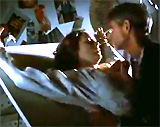    The Reverend's Death - Stabbed in Back with Dildo |
|||||||||
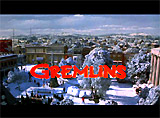
|
Gremlins (1984) Director Joe Dante's horror comedy was about the small town of Kingston Falls besieged by a group of sadistic, furry reptilian creatures that were unleashed when three rules about their care were neglected:
Dog-hating, cold-hearted, crabby, and wealthy cat-lady spinster Mrs. Ruby Deagle (Polly Holliday) died a spectacular death by jet propulsion. The miserly realtor was startled and annoyed by the sound of Christmas carolers outside her door ("I hate Christmas carolers. Screechy-voiced little glue-sniffers"), similar to Ebenezer Scrooge's possible reaction. She was going to toss water on the singers, when she was shocked by the sight of gremlins outside her porch. She rushed back inside, locked her door, and then fearful of dying cried out: "What are they? They're here. Oh, they've come for me!...I'm not ready! I'm not ready yet!" She suffered a mild heart-attack. In the meantime, one of the gremlin creatures had snuck in through a cat door, and then tinkered with and modified her motorized chair-elevating stairlift.
She sat on her chairlift to take her upstairs, which sent her careening up her long circular staircase's bannister at high speed, and by a picture of her dead husband mounted on the wall. The stairlift launched her to crash out of the second story window like a cannonball, and landed her head-first into snow. She died there, as Police Department Sheriff Frank (Scott Brady) noted to his partner in a patrol car: "My God, Frye! That was Mrs. Deagle." In the film's conclusion set in a department store, vicious red-eyed Mogwai leader Stripe (voice of Frank Welker) with a white tuft of hair (and sharp teeth and claws), was the last gremlin to die - a very gooey death. He discovered a water fountain in the garden center, put his finger in the water, and began the process of replicating (eggs bubbled up on his back). However, unlikely hero Gizmo (voice of Howie Mandel) came to the rescue. Driving in a Barbie toy Corvette, Gizmo crashed into the garden center wall and opened the blinds - sunlight poured into the area. During Stripe's long and drawn-out death scene, as he decomposed and turned to goo, he twitched and convulsed and his eyes turned white. Green mucus flowed and drained from his mouth and nose. As he melted, his body fell apart and he fell into the pool of water, causing further smoke and light to emanate. He emerged one more time from the water in a jump-scare, fell onto the floor, but then completely collapsed. |
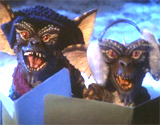 Christmas-Caroling Gremlins 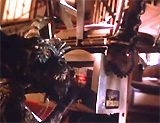 Gremlin Tinkering with Chairlift  Headfirst Into Snow  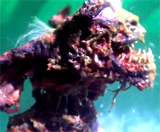  Stripe's Gooey Melting Death - Exposed to Sunlight |
|||||||||

|
Indiana Jones and the Temple of Doom (1984) Director Steven Spielberg's second action-adventure film in the series trilogy was darker and more violent. Again, Indiana Jones (Harrison Ford) encountered threats - this time in the sub-continent of India in the mid-1930s, personified by a Thuggee religious cult. He was accompanied on his exploits by kid sidekick Short Round (Ke Huy Qan) and complaining, spoiled nightclub singer Willie Scott (Kate Capshaw). The film's notorious, prolonged death scene was so horrifying that it ultimately caused the creation of a new rating -- PG-13. In a subterranean Temple of Doom, a religious cult was conducting ritualistic worship ceremonies to appease the Hindu goddess Kali. A large statue of the bloodthirsty goddess Kali held three glowing sacred Sankara Hindu stones in its altar (within the eye sockets and nose of a giant skull). The Thuggees believed that the three magical stones (there were five stones total) gave them immense control over the minds of other people, and even the Maharajah. The infamous, slightly-sexualized Thuggee sacrifice/torture scene ritual was led by demonic and crazed high priest Mola Ram (Amrish Puri). The human sacrifice victim (Nizwar Karanj) was led in, and shackled inside a large iron cage. Then Mola Ram recited some spiritual phrases, clenched his right hand and plunged it into the victim's chest - and ripped out the man's still-beating heart and held it up in his right hand.
The screaming victim remained alive and was lowered into a red-hot magma pit where he was incinerated, while the other worshippers worked themselves into a frenzy. When the victim's body burst into flames, the heart still in Mola Ram's hand also caught fire. |
 Victim Led In and Placed in Wire Cage  Mola Ram Holding the Dripping, Still-Beating Heart     The Sacrificial Victim Lowered into Magma Pit  The Flaming Heart |
|||||||||

|
A
Nightmare on Elm Street (1984) Wes Craven's original horror-slasher film of the long-running series introduced the character of a badly-scarred, demonic dream killer and vengeful child murderer named Freddy Krueger (Robert Englund) with "finger-knives" on a glove, who preyed on a number of Midwestern teens living in Springwood, Ohio - during their sleep. The parents of the kids living on Elm Street had been keeping a dark secret about the past - that a psychopathic killer known as the "Springwood Slasher, " who was accused of child murders, was inexplicably released on a technicality. The angered and grief-stricken parents of the victims sought vigilante revenge, and burned the suspect alive in a boiler room. The teens didn't realize that as the children of the parents who had slain Krueger, they had become the latest victims - experiencing horrifying and deadly nightmares. Heroine Nancy Thompson's (Heather Langenkamp) boyfriend Glen Lantz (Johnny Depp in his feature film debut) suffered a liquified death in his own bedroom. He had drifted off to sleep while sprawled back fully-clothed on his bed with a blaring TV on his lap, and wearing headphones. Freddy Krueger's clawed hand burst through a hole in the center of the bed under him, sucked, swallowed and pulled him through the bed cover down into the hole (along with the TV, stereo, bed covers, pillow, sheet, and headphones, etc.). He was reduced to a bloody geyser or torrential column of his shredded remains that exploded (or were vomited) out of the hole and gushed toward the ceiling, drenching and spraying the room with his blood and gore.
|
  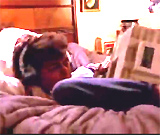  Sucked Through The Center of the Bed |
|||||||||

|
Red Dawn (1984) This famous US homeland invasion war film from director John Milius was the first film to be released with the MPAA's PG-13 film rating, due to its extreme violence. It was a fictional account of a Soviet invasion of the US - the beginnings of WWIII. Robert Morris (C. Thomas Howell) was one of the defending teenaged high-school students in the small town of Calumet, Colorado, who sought refuge in the mountainous hills from invading Russian soldiers (and their Latin American allies, including Cuba and Nicaragua). The defensive group used a fighting tactic known as guerrilla warfare. Soon, the town became an "occupied" zone, taken over by the foreign troops and patrolled by tanks. And most of the local men had been taken to a re-education camp outside town. Later, much of the US became occupied, and nuclear missiles had destroyed Omaha, Nebraska, Kansas City, Kansas, and Washington, D. C., and all of Europe, except England, that had refused to intervene in the conflict. Robert had joined other young people, calling themselves Wolverines (after their high school's mascot), to resist the occupation. Eventually, Robert died in a hail of smoke and heavy gunfire from an approaching Soviet Mi-24 helicopter gunship filled with paratroopers, as he cried out:
The names of the fallen Wolverines and other dead loved ones were etched on a rock. Years later, after the conflict ended and the US was freed, the rock bearing the names had become a monument called Partisan Rock. |
  Robert: "Wolverines!"  
|
|||||||||

|
Star Trek III: The Search for Spock (1984) This third entry in the original series of Star Trek films followed the death of a major figure in Star Trek II: The Wrath of Khan (1982) - Vulcan Spock (Leonard Nimoy). The crew of the USS Enterprise now faced threats from menacing and hostile Klingons. The Federation Starship, the USS Enterprise and its Captain Kirk (William Shatner) made a deal with menacing and treacherous Klingon Commander Kruge (Christopher Lloyd). (Earlier, Kruge had killed Kirk's son, Project Genesis research scientist Dr. David Marcus (Merritt Butrick)). Kirk demanded that everyone else be beamed up to the Klingon Bird of Prey, to be saved, in order to meet Kruge's demands, who insisted:
Kirk was willing to promise Kruge that he would receive the secret to Project Genesis. Kruge wrongly believed that he could use the device as a weapon.
Kirk bargained with Kruge to allow his crew to escape the Genesis planet's self-destructing deterioration (from the experimental terraforming device). Although Kirk warned: "You fool, look around you. The planet's destroying itself," Kruge gleefully noted:
Kirk argued that they had to work together: "If we don't help each other, we'll die here." Kirk remained on the disintegrating planet of Genesis for a climactic one-on-one, hand-combat fight to the death against Kruge. They began wrestling each other, and Kruge put Kirk in a strangle-hold, while calling out: "Give me Genesis!" When tackled and after more struggling, the Klingon fell onto a broken-off ledge overlooking a sea of lava, and was gripping onto the edge. Kirk at first chivalrously offered to help ("Take my hand!"), but Kruge instead grabbed his ankle, and attempted to pull Kirk off the ledge with him. Kirk then push-kicked (three times) the Klingon to his death off the cliff into a molten lava lake while punctuating his words with each kick:
|
 Klingon Commander Kruge (Christopher Lloyd)  Commander Kirk (William Shatner)  Kirk in Stranglehold     Capt. Kirk vs. Klingon Kruge on Ledge |
|||||||||

|
Director James Cameron's movie was the first of four science-fiction action-thriller films. It was set in post-apocalyptic 2029 Los Angeles, when an indestructible, invincible, inhuman cyborg Terminator T-800 (Arnold Schwarzenegger) was sent back from the future year 2029 to 1984 to eliminate Sarah Connor (Linda Hamilton). She would one day be the mother of a son (an off-screen John Connor) who was to lead a human Resistance movement-rebellion against the evil cyborg leaders of Earth's future. The Terminator was first burned down to his exoskeletal frame when the oil company tanker-truck that he commandeered was blown up and consumed in a fiery inferno. The exterior synthetic skin of the T-800 Terminator was burned away, and only the unstoppable cyborg's metal exo-skeletal frame (with glowing red eyes) remained. Surprisingly, the skeletal Terminator survived, rose out of the flames, and followed Kyle Reese (Michael Biehn) and Sarah Connor on foot into an automated factory, filled with giant robotic, hydraulic-powered machines. As Reese commanded Sarah to flee, he valiantly and vainly struck the metallic cyborg with a round steel bar, but was back-handed with the robot's right hand and further hurt. He sacrificed himself when he placed another homemade bomb into the Terminator's open torso, successfully blowing away its lower half. Sarah's left thigh was severely-injured by sharp flying debris from the blast, and the surviving upper-half of the relentless cyborg with a shiny chrome skeleton continued to crawl after her. She escaped death by strangulation, by luring the cyborg underneath a massive hydraulic press. The final crushing destruction of the shiny Terminator came with the factory's industrial hydraulic steel press machine. As she pressed a red START button on the machine's control panel to initiate the process, she growled out:
Lightning bolts snapped out from the flattened cyborg. The cyborg's glowing red eyes finally dimmed, darkened, and extinguished. |
 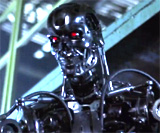 The Terminator's Exo-Skeletal Frame  The Terminator Crushed: "You're terminated!" |
|||||||||
(chronological by film title) Intro | 1915-1929 | 1930-1933 | 1934-1938 | 1939 | 1940-1942 | 1943-1945 | 1946-1947 | 1948-1949 1950-1952 | 1953-1955 | 1956-1957 | 1958-1959 1960-1961 | 1962-1963 | 1964-1966 | 1967-1968 | 1969-1970 1971 | 1972 | 1973 | 1974 | 1975 | 1976 | 1977-1978 | 1979 1980 | 1981 | 1982 | 1983 | 1984 | 1985 | 1986 | 1987 | 1987 | 1988 | 1989 1990 | 1991 | 1992 | 1993 | 1994 | 1994 | 1995 | 1995 | 1996 | 1997 | 1998 | 1998 | 1999 2000-2001 | 2002 | 2003 | 2004 | 2005 | 2006 | 2007 | 2008 | 2009 | 2010 | 2011 |